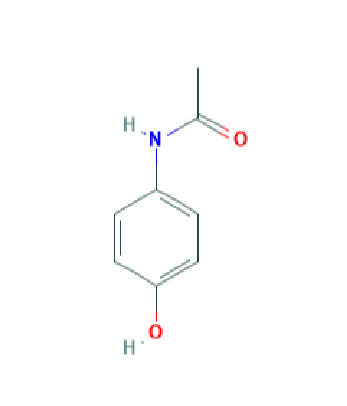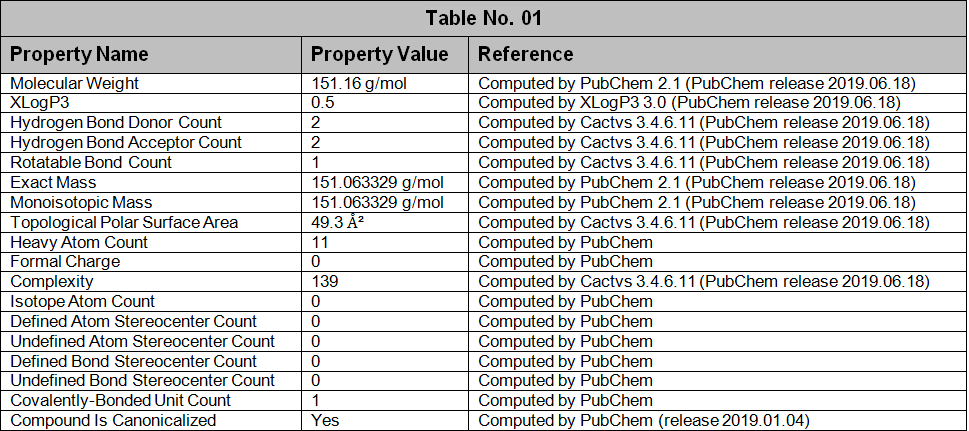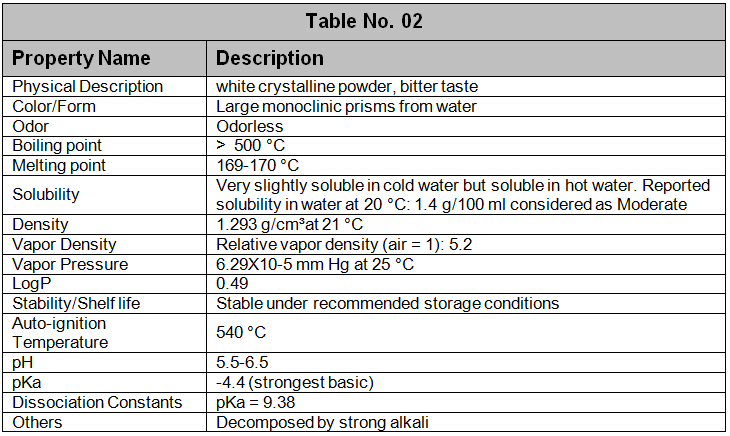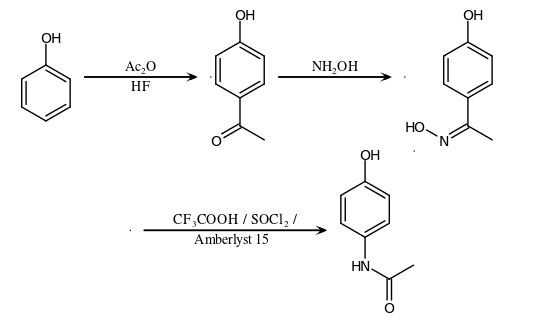Noor SalehDecember 11, 2020
Tag: Paracetamol , Aniline Analgesics , APAP
1. What is Paracetamol? (1), (4)
Paracetamol belongs to a class of drugs called Aniline Analgesics. It does not belong to the NSAIDs family and it lacks the anti-inflammatory activity.
Other names for Paracetamol are: Acetominophen and Acetyl Para-Amino Phenol, abbreviated as APAP.
The following figure no. 01 illustrates the chemical structure of this compound.

Figure No. 01: Chemical 2D Structure of Paracetamol
IUPAC Name: N-(4-hydroxyphenyl) acetamide
CAS Number: 103-90-2 (1)
This compound is sold worldwide under different trade names, such as:
1. Adol
2. Calpol
3. Pain Relief
4. Panadol
5. Panamax
6. Panda
7. Paramol
8. Perfalgan
9. Revanin
10. Tylenol
The following table No. 01 summarizes all the chemical characteristics of Paracetamol (1).

The following table no. 02 summarizes the main physical properties of Paracetamol material (1).

2. What are the specifications of Paracetamol?
For the detailed technical specification of Paracetamol raw material (e.g. physical description, identification, assay, purity, elemental analysis, residuals, related substances, etc…), you can easily search through PharmaSources.Com platform for all relevant suppliers who are going to respond to any of your enquiries. You can either search in the information available in each supplier`s profile, or inquire the relevant Drug Master File (DMF) or Certificate of Analysis (COA) directly for any extra details.
3. How Paracetamol is produced? (1),(4)
3.1. Original (Boots) method:
The original method for production involves the nitration of a phenol ring with sodium nitrate to give a mixture of two isomers. The preferred one which is: 4-nitrophenol that has a boiling point of 279 °C can be easily separated using the steam distillation. After that, the added nitro group will be reduced to an amine, giving the 4-aminophenol. As a last step, the amine group will be acetylated (e.g. using heat and a mixture of acetic anhydride and glacial acetic acid) to give Acetyl Para Amino Phenol (APAP). The following figure no. 02 illustrates this synthetic route.

Figure No. 02: The Original (Boot) Method (4)
3.2. Green Synthesis:
Another method developed by Hoechst–Celanese involves direct acylation of a phenol ring with acetic anhydride catalyzed by HF, followed by subsequent conversion of the ketone group to a ketoxime with hydroxylamine which will be subjected to the acid-catalyzed Beckmann rearrangement to give the amide group. The following figure no. 03 illustrates this route.

Figure No. 03: The Green Synthesis Method (4)
3.3. Direct Synthesis:
It is called "one-pot" synthesis which involves mixing hydroquinone, ammonium acetate, and acetic acid in an argon atmosphere. This mixture will be heated slowly to 230 °C and stirred at this temperature for 15 hours. After cooling, the acetic acid will evaporate, the precipitate will be filtered, washed with water and dried to give Paracetamol as a white solid.
4. What are the uses of Paracetamol and how does it work? (1),(2),(3)
Paracetamol which is available in many dosage forms is used mainly as a non-narcotic analgesic (i.e. pain killer) and as an antipyretic. While its exact mechanism of action is not known, it is widely used for treating many conditions, such as: headache, muscle aches, arthritis, backache, and toothaches.
Because of its low risk of causing allergic reactions, it can be given safely for patients who are intolerant to salicylates (e.g. Aspirin®) and those with allergic tendencies, including bronchial asthmatics.
The common available dosage forms of Paracetamol include:
1. Oral capsule
2. Oral tablets
3. Chewable oral tablets
4. Oral liquid
5. Oral suspension
6. Rectal suppository
7. Intravenous solutions
Other non-clinical uses reported in the literature include(1):
1. Manufacturing of Azo dyes and photographic chemicals
2. A stabilizer for Hydrogen peroxide
5. What are the Pharmakokinetics and Pharmacodynamics of Paracetamol?(3)
This compound is proven to act as an analgesic and an antipyretic. As it lacks the anti-inflammatory activity, it does not affect the tubular secretion of uric acid or the acid – base balance (as opposed to salicylates). Also, it does not induce an allergic reaction or disrupt the homeostasis.
Paracetamol is considered as pregnancy category C drug.
1. Oral bioavailability of Paracetamol: 85%
2. Time to reach the highest plasma concentration after ingestion: 90 minutes
3. Volume of distribution: 0.9 L/kg (protein binding is 10 to 25%)
4. Metabolism: First pass effect (through liver)
5. Route of elimination: Urine (90% of the administered dose will be excreted 24 hours after its intake)
6. Half life in adults: 2.5 h after an intravenous dose of 15 mg/kg
7. Clearance: 0.27 L/h/kg following a 15 mg/kg intravenous (IV) dose.For children: 0.34 L/h/kg following a 15 mg/kg intravenous (IV) dose
8. Toxicity: LD50 = 338 mg/kg (oral, mouse) & LD50 = 1944 mg/kg (oral, rat)
6. What is the recommended dosage of Paracetamol?(2)
Doses may be given as single or repeated doses as follows:
A. Parenteral:
A.1 Weight ≥ 50 kg: 1000 mg IV every 6 hours
Maximum Single Dose: 1000 mg
Minimum Dosing Interval: every 4 hours
Maximum Dose: 4000 mg per 24 hours
A.2 Weight < 50 kg: 15 mg/kg IV every 6 hours
Maximum Single Dose: 15 mg/kg
Minimum Dosing Interval: every 4 hours
Maximum Dose: 75 mg/kg per 24 hours
B. Oral:
B.1 Immediate-release: 325 mg to 1 g orally every 4 to 6 hours
Minimum Dosing Interval: every 4 hours
Maximum Single Dose: 1000 mg
Maximum Dose: 4 g per 24 hours
B.2 Extended-Release: 1300 mg orally every 8 hours
Maximum dose: 3900 mg per 24 hours
C. Rectal:
650 mg rectally every 4 to 6 hours
Maximum dose: 3900 mg per 24 hours
Renal Dose Adjustments
Severe renal impairment (ClCr < 30 mL/min): Longer dosing intervals and a reduced total daily dose may be warranted.
Liver Dose Adjustments
IV Paracetamol is contraindicated in case of sever hepatic impairment. Total daily dose needs to be reduced in case of mild to moderate hepatic impairment.
Intake of oral Paracetamol should not exceed the maximum daily dose for adults in 24 hours, and children should not take more than 5 doses in 24 hours as well.
Note that the maximum daily dose and the dosage regimen may differ from product to product, always consult your doctor and refer to the information mentioned in leaflet for any further details (e.g. drug-drug interactions, black box warnings, precautions, etc…). If you want to purchase this kind of drugs, then you could get it from medical supply companies online. Pharmasources would help you!
7. What are the common side effects of Paracetamol?(2)
This compound is well-tolerated when given at the recommended doses. The common side effects include: nausea, vomiting, constipation, injection site pain and reaction if given through the IV route.
The following side effects are rare but an urgent medical attention is required in case of their appearance:
1. Bloody or black, tarry stools
2. Bloody or cloudy urine
3. Fever with or without chills
4. Pain in the lower back and/or
5. Pinpoint red spots on the skin
6. Skin rash, hives, or itching
7. Sore throat
8. Sores, ulcers, or white spots on the lips or in the mouth
9. Sudden decrease in the amount of urine
10. Unusual bleeding or bruising
11. Unusual tiredness or weakness
12. Yellow eyes or skin
The following symptoms of overdose require urgent medical help as well:
1. Diarrhea
2. Increased sweating
3. Loss of appetite
4. Nausea or vomiting
5. Stomach cramps or pain
6. Swelling, pain, or tenderness in the upper abdomen or stomach area
8. Where to buy Paracetamol in bulk?
For any enquiries related to the commercial supply of Paracetamol raw material, search directly in PharmaSources.Com database which includes a large number of reputable suppliers of this material. Consult the profile of each manufacture or distributor to ask for the details concerning: the monograph, the manufacturing method, the COA, as well as the logistics of the shipment process (e.g. price per Kg, Kg per drum, min QTY in order, storage conditions, etc…).
9. Reference and links?
1. https://pubchem.ncbi.nlm.nih.gov/compound/Acetaminophen
2. https://www.drugs.com/paracetamol.html
3. https://go.drugbank.com/drugs/DB00316
4. https://en.wikipedia.org/wiki/Paracetamol
About the Author
Name of the Author: Noor A. Saleh.
An industrial pharmacist with more than 5 years of experience in the field of pharmaceutical manufacturing, who has a deep GMP knowledge in the following areas: handling of all types of document management activities in alliance with ICH, FDA, Eudralex & PIC/S guidelines, handling of deviations, out-of-specification (OOS) reports, and all types of suppliers’ nonconformities, issuing of Annual Product Quality Reviews (APQRs) and Quality Metrics report, and following up the qualification activities of all new suppliers and reviewing their technical agreements.


Contact Us
Tel: (+86) 400 610 1188
WhatsApp/Telegram/Wechat: +86 13621645194
+86 15021993094
Follow Us:




 Pharma Sources Insight July 2025
Pharma Sources Insight July 2025


